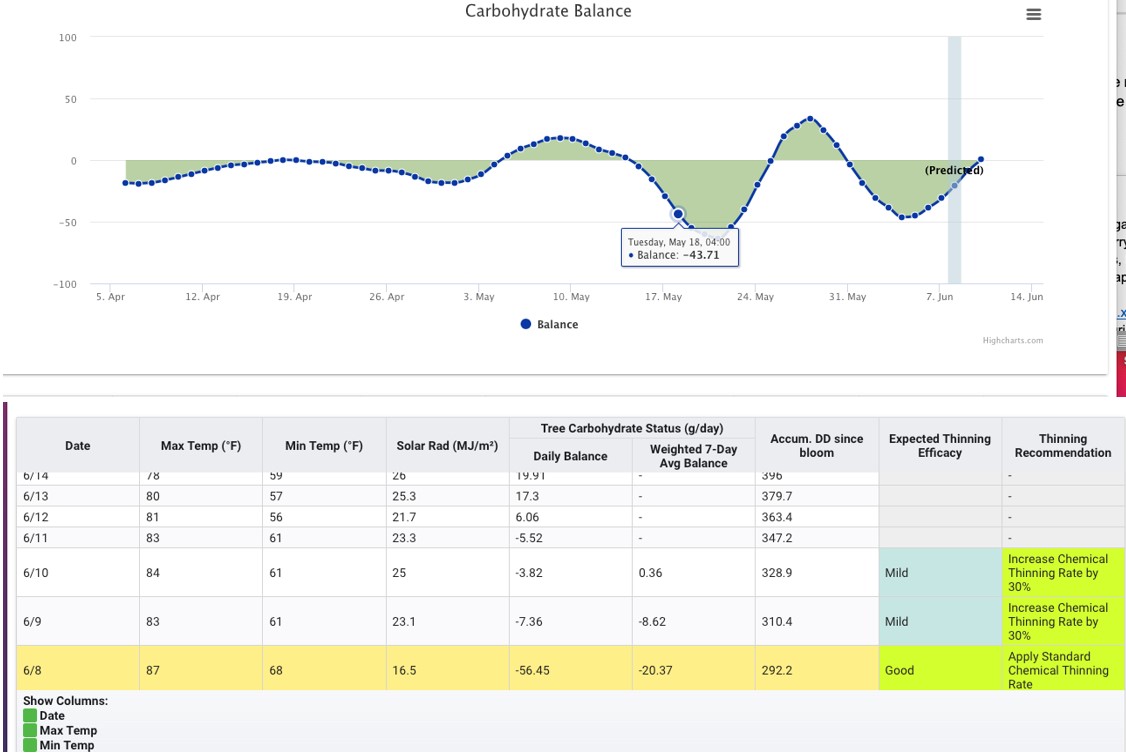Northwest Michigan fruit update – June 8, 2021
This hot weather has moved along the crop, but the region could use some rain.

Weather report
Well, summer certainly has arrived across the region. We have had some very hot daytime temperatures as well as some high overnight temperatures. The daytime temperatures have been in the low to mid- to high 80s in the past five days. Overnight temperatures have only dipped a few degrees into the high 70s. This weather feels much more like July than early June. The hot weather has been a bit surprising, but the lack of water/moisture is concerning. The whole state is some level of droughty conditions and our region is unconditionally dry.
The Northwest Michigan Horticulture Research Center Enviroweather station has not recorded any rainfall since May 28. With the recent heat, we have accumulated 904 growing degree days (GDD) base 50 and 511 GDD base 42. Our 31-year average is at 758 GDD base 50 and 398 GDD base 42.
The weather forecast will continue to be warm and humid. There are thunderstorms possible on a daily basis all the way through Friday, June 11. Conditions will cool by early next week, but the daytime highs will still be in the mid- to lower 80s. The medium range forecast will be drier than normal for the remainder of next week.
View Michigan State University state climatologist Jeff Andresen’s weekly weather report.
Crop report
The crop is moving along with this heat. Sweet cherries are at 11-13 millimeters and tart cherries are at 12-13 millimeters. Apples are also sizing and are at 13-18 millimeters. Hopefully, most growers are finishing up their thinning as the size of apple fruitlet is approaching a difficult to thin size! We measured Gala fruitlet size at the Northwest Michigan Horticulture Research Center this morning, and we are excited that our thinning program was successful last week. We are close to our goals of 52 per fruit per tree (Figure 1).
For growers that are still thinning, the carbohydrate model is looking optimal for good conditions (Figure 2), but fruit size could be an issue for many farms. Fruit is difficult to thin once the fruitlet size exceeds 15 millimeters.

Pest and disease report
The good thing about the dry weather is the lack of fungal infections. We have not recorded an infection period for apple scab since May 21 and a cherry leaf spot infection since May 25. Be on guard for future infection periods, but the weather forecast is continuing to predict warm and dry. Please check out the RIMpro apple scab data below:
Insects
We are still catching American plum borers. We captured an average of 5.6 moths this week. Lesser peach tree borer numbers are up this week; we caught an average of 16 moths compared to just under a moth per trap last week. Growers that are targeting trunk sprays should consider this time to catch both American and lesser; however, we haven’t caught any greater peachtree borer yet this season.
We are still catching a few oriental fruit moth and San Jose scale are staying steady with an average of 53 males this week, which is similar to last week of 59. Begin sprays for San Jose scale next week.
Codling moth numbers are up slightly at the Northwest Michigan Horticulture Research Center this week, and we caught an average of three moths this week. Growers with codling moth issues should be making applications for codling moth control as we are at the 250 GDD timing. Black stem borer trap numbers are down this week (average two per trap), so growers should be done with spring applications for this pest.



 Print
Print Email
Email




